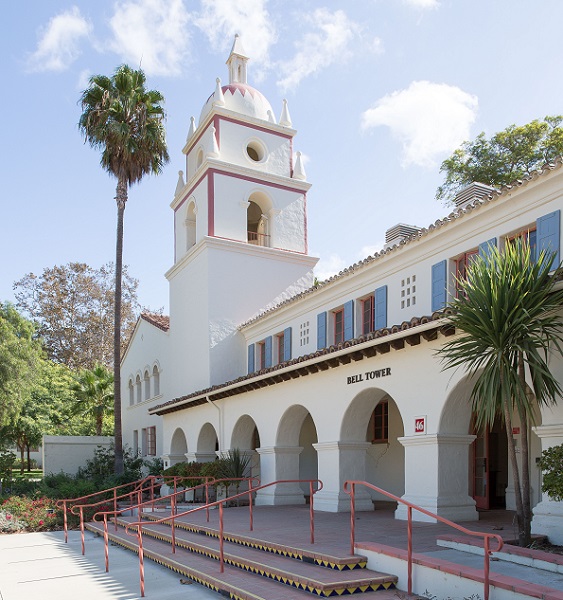CAMARILLO — Two national studies about college campuses and COVID-19 suggest that the California State University’s (CSU) early decision to pivot all 23 of the CSU campuses to virtual instruction went a long way toward keeping communities safer throughout the state.
“Both reports carried a similar message that campuses can be super-spreaders of the virus,” said Vice Chair of the CSUCI Academic Senate and Professor of Mathematics Jason Miller, Ph.D., who reviewed the two studies and extrapolated the results for CSUCI.
“Our campus has taken the steps that have helped keep it from contributing to the county’s problem,” he said. “We aggressively depopulated the campus and that has helped us protect the county. As a result, very few students have been infected.”
CSUCI’s Interim President Richard Yao, Ph.D., praised how quickly and efficiently all sectors of the campus responded when former CSU Chancellor Timothy P. White declared on March 17, 2020 that the nation’s largest university system would switch its campus operations and instruction to a virtual platform. Many other universities across the nation spent months grappling with the dilemma of how to keep infections down while still holding in-person classes.
“There’s no question that the CSU’s early, decisive action kept our campus safe, but it’s especially gratifying to hear that CSUCI’s swift and ongoing actions, as well as continuing to work with our local public health officials has helped to keep the infection rate down in the county,” Yao said. “We have always valued our close connection to the region, so we’re pleased that data shows how this historic move made such a difference.”
Ventura County Public Health Officer Robert Levin, M.D., agreed that CSUCI going virtual benefited the entire county.
“Closing their campus was no easy decision and was at no small cost, but they did a service to all of us in limiting the spread of this pandemic locally,” Levin said.
According to the New York Times, almost 400,000 cases of COVID-19 have been reported across 1,800 colleges and universities in the United States since the beginning of the pandemic in Spring 2020.
To date, out of approximately 7,000 CSUCI students, 1,000 employees, and a limited number of vendors, there have been a total of 29 positive COVID-19 cases of individuals who have been on the campus during the infection period. Of those cases, 21 occurred in 2020 and eight have occurred in 2021.
One of the national reports, published Jan. 8, 2021, came from the Centers for Disease Control, which kept track of COVID infections in counties with large universities from July 6 to Sept. 17, 2020. Their findings showed that large colleges or universities that used remote instruction experienced a 17% reduction in infections countywide compared with university counties with in-person instruction, which experienced a 56% increase in infections.
The other report published on Jan. 13, 2021 in Taylor & Francis (T&F) online, is entitled: “Are college campuses super-spreaders? A data-driven modeling study.”
Taylor & Francis Group is an international company based in England that publishes books and academic journals.
“The second study had a similar message using different data and different methods,” said Miller. “Both conclusions are in agreement and they took two different approaches. That indicates they’re onto something.”
The T&F study, which was conducted by six researchers from Stanford University, suggested that it was prudent for college campuses to learn from the mistakes of the Fall semester.
“While early policy makers had hoped to create local bubbles of a COVID-19 free campus environment, we now know that the virus spreads rapidly among students and that local campus outbreaks are often linked to spiking case numbers in neighboring communities,” read part of the T&F study.
Miller is on a CSUCI task force charged with creating a game plan for campus instruction as the county moves through the vaccination phase and eventual return to in-person classes. Miller said the campus is prepared to return to in-person instruction in Fall 2021 but adds that the campus will continue to exercise a compassionate, conservative approach on the road back to normal.
“I think we need to respect science and take our cues from the science of the disease,” Miller said. “We are still trying to understand these virus variants and continue to walk a tightrope between what society needs economically and what society needs medically.”
Associate Professor of Communication Nien-Tsu “Nancy” Chen, Ph.D. conducted a separate COVID-related study that researched factors that determine people’s support or lack of support for public health measures and policies. Chen believes clear and honest communication about the constantly-changing situation caused by the pandemic beginning in Spring 2020 was indispensable.
“I think our University has done a great job in being transparent with everything that was going on when we decided to go online,” Chen said. “We set up a website to provide any new information that was transparent about what we knew and what we didn’t know. It really helped to build trust.”
To view the studies visit:
https://www.tandfonline.com/doi/pdf/10.1080/10255842.2020.1869221?needAccess=true and
https://www.cdc.gov/mmwr/volumes/70/wr/mm7001a4.htm.
About California State University Channel Islands — CSU Channel Islands (CSUCI) is reimagining higher education for a new generation and era. We are an innovative higher education institution that enables students to succeed and thrive – serving as an engine for social and economic vitality that provides the intellectual resources necessary for a thriving democracy. With more than 7,000 students, 1,200 employees and 14,000 alumni, CSUCI is poised to grow in size and distinction, while maintaining one of the most student-focused learning environments in public higher education. Connect with and learn more by visiting www.csuci.edu or CSUCI’s Social Media.

